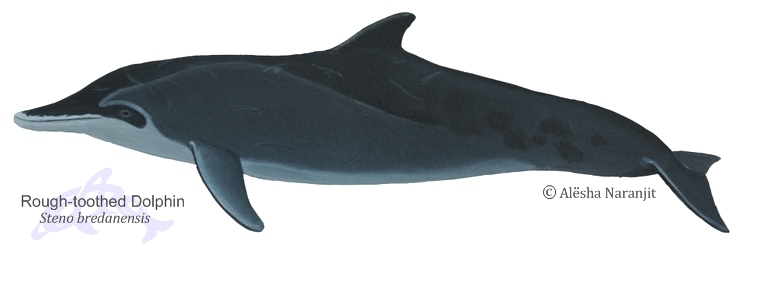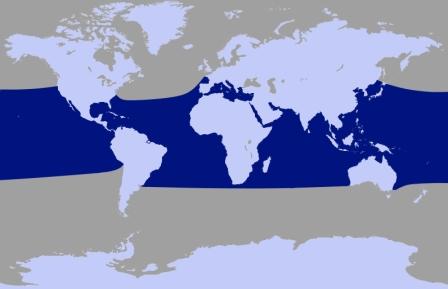Steno bredanensis

Classification Other Names: Slopehead, Steno Suborder: Odontoceti Family: Delphinidae | Description
Rough-toothed Dolphins are said to have a reptilian appearance because they lack the usual crease between the melon and beak. Their heads are conically shaped, sloping smoothly from the blowhole and end with a whitish-pink tipped beak and whitish-pink lips. Individuals are generally dark grey in colour with a darker cape boardered in paler grey. The flippers are proportionally large and set far back, and the dorsal fin is tall and centrally positioned. White scratches and spots often cover the body. Although usually not active in the water the Rough-toothed Dolphin is a powerful swimmer and sometimes seen doing shallow breaches and bow- or wake-riding. They are often seen swimming shoulder to shoulder and associate with debris, pilot whales, spinner, spotted and bottlenose dolphins.
|
Rough-toothed Dolphin Ecology Range: Tropical and subtropical waters generally between 40ºN - 35ºS. Usual Habitat: Generally found in deep oceanic waters but in some areas, including Trinidad and Tobago, they are also found in shallow coastal waters. Usual group size: Generally close-knit groups of 10-20, but can be found in groups of 50 to 300 individuals. Main Diet: Cephalopods (such as squid and octopus) and fish (including large fish such as mahi-mahi). Local population: Unknown | Global range of the Rough-toothed Dolphin  Dark blue areas indicate where Rough-toothed Dolphins are likely to be found |
Protection and Conservation Status
IUCN Conservation Status: Rough-toothed Dolphins are listed as "Least Concern" on the IUCN red list. SPAW Protocol: Rough-toothed Dolphins are cetaceans, which are listed under Annex II of the SPAW protocol. As such they require total protection under article 11 of this protocol which prohibits the "taking, possession, killing and commercial trade of the species, their parts or products". The SPAW protocol was created to help with the implementation and promotion of the Ramsar Convention and the Convention on Biological Diversity. The Annexes of the SPAW protocol can be found here. Local Laws: Cetaceans are protected under the Conservation of Wildlife Act of Trinidad and Tobago which offers protection to all species not listed under the second or third schedules of this act. |
This is currently being researched and written. It will appear here shortly.
References
The above information was obtained from the following sources:
- A Princeton Field Guide: Whales Dolphins and Other Marine Mammals of the World by Hadoram Shirihai and Brett Jarrett (2006)
- Smithsonian Handbooks: Whales Dolphins and Porpoises by Mark Carwardine and illustrated by Martin Camm (2002)
- The Whale and Dolphin Conservation Society's Species Guide at http://www2.wdcs.org/species/index.php
- The IUCN Redlist at http://www.iucnredlist.org
- The SPAW protocol Annexes with links available at http://www.car-spaw-rac.org/?Annexes-of-the-SPAW-Protocol,83
Acknowledgements
We would like to thank the following people for the use of the art work and photographs:
- Alësha Naranjit (Illustration of Rough-toothed Dolphin)